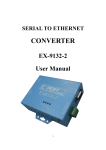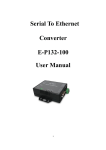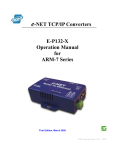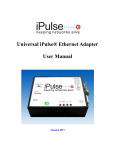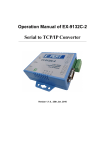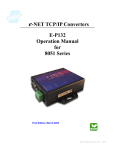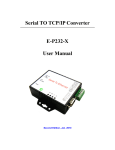Download Expert EX-9132-2 User`s manual
Transcript
EX9132C-DIO Digital I/O User’s Manual 1. Specification 2. Hardware 3. Wiring 4. Command Set 5. Converter Configuration 6. Self-Testing 7. Appendix A------------FAQ 8. Appendix B -----------Pin outs and Cable Wiring 1. Specification Digital Input ¾ Channel numbers : 2 Port ¾ Active High / Active Low Selectable ¾ Isolation voltage : 3.75K Vrms ¾ Status indicator : 2 input status LED display ¾ Wet contact : Logic level 0 : 0~1 V MAX , Logic level 1 : 3.3V ~ 30 V MAX ¾ External Dry contact : Logic level 0 : close to GND , Logic level 1 : open Digital Output ¾ Relay output ¾ Channel numbers : 2 Port ¾ Relay coil voltage : 5V ¾ Contact rating: 24VDC @ 10A 120VAC @ 10A 240VAC @ 7A Others ¾ Power : DC 5 V , 150 mA@5V (Full ON) ¾ Output screw terminal voltage 5V or 12V ¾ Led Lamp : ¾ Environment : Operating Temperature: 0℃∼70℃ DI-1 ,DI-2 , DO-1 , DO-2 Storage Temperature : -10℃∼80℃ ¾ Dimensions : 75 * 35 * 20 mm ( W * D * H ) ¾ Weight : ¾ Power consumption: < 1W ¾ RoHS : Compliant with RoHS ¾ Regulatory Approvals : EMC : FCC Class A, CE Class A ¾ WARRANTY : 50 gm 1 year 2. Hardware Interface : Block Diagram: 3.Wiring: Digital Output Digital Input 4. Command Set When you connect the socket port of Digital I/O : 101 It will return the status of the TTL Digital I/O ; the default value is “11111111” TTL Digital I/O total has 8 pins ; but the Digital I/O module is DO *2 & DI*2 DO-1 is pin 7 ; DO-2 is pin 8 ; DI- 1 is pin 5 ; DI- 2 is pin 6 Digital Output Command set is easy for you, The default of every pin is “11111111” . it is active low for Digital I/O , when you want to set DO-1 ( PIN 7 ) active , The command set is “ 070 “,“07” mean pin nr.“0” mean low status of Digital I/O pin 7. It will return the value “11111101” from digital I/O port. If you want to change the Digital Output Status to High , The command set is “071 “ , It will return the value “11111111” from digital i/o port. You can use Hyper-Terminal to control DO & mornitor DI status : Press Dial-up , converter will response Digital I/O status “11111111” to Host Digital I/O set pin 07 & 08 as Digital Output , set pin 05 &06 as Digital Input When you want to set DO-1 active , type “070”and press Enter key , it will return “11111101” status to Host We will set DO-1 link to DI-1 , when DO-1 active ,DI-1 is active too Pls see following response. Set DO-1 to off , type “071”and press enter key , it will return “11111111” status to Host , Due to DI-1 is link to DO-1 , DO-1 off , DI-1 is off too Digital Input Status : You can connect to the digital I/O port socket . It will return the status of 8 pins of Digital I/O – “11111111” 5 Converter Configuration Initial IP Configuration When setting up your converter for the first time, the first thing you should do is configure the IP address. This chapter introduces the method to configure the device server’s IP address. For more details about network settings, see “Web Console Configuration”. in next sub section. For quick and easy start , We suggest you to reference “Quick Installation Guide” manual. The following topics are covered in this chapter: □□ Device Management Utility □□ Menu “View” □□ Menu “Config” Device Management Utility On PC we provide a Device Management Utility named ExpertDAQETM.exe which is an executable program in Windows 32 bit environments. ExpertDAQETM Setup Tool is used to detect and setup the installed converters. It uses UDP broadcast packets to query and configure converters on the network. When you activate the tool, it will detect the existence of the installed converters and depict the converters’ status such as IP address, Subnet Mask, MAC Address, and Device ID (see Figure 3.1). time. The Setup Tool only can setup one converter at a Thus if there are more than one converter on the network, please shut down or disconnect other converters. Otherwise the ExpertDAQETM.exe can not detect the converter. Other similar issues, you may reference to Q&A in Appendix A. Due to the nature of broadcast UDP packets, ExpertDAQETM has following characteristics: □□ Broadcast packets aren’t limited by subnet. Even if the IP address of the converters and the computer running ExpertDAQETM do not belong to the same subnet, it still works fine. □□ Broadcast packets can not pass routers. ExpertDAQETM can only be used to monitor devices with computer running ExpertDAQETM in the same segment of local area network (Figure 5.1) Menu “View” □□ View -> Refresh F5 Refresh the status. ExpertDAQETM will send another query to get updated information.(see Figure 5.2). Note: Always run the “View-> Refresh” after any data change. (Figure 5.2) □□ View -> Exit Alt+F4 Exit from the program (see Figure 5.2). Menu “Config” □□ Config -> IP Address (see Figure5.3) (Figure 5.3) Press ENTER or select [IP Address] in the [Config] menu, a dialog will be shown (see Figure 5.4). Note : Because ExpertDAQETM uses broadcast UDP packets, for the sake of security, it allows configuration only when device's setup password is empty. (Figure 5.4) Assign an IP Address with the same Subnet Mask of your computer, avoiding any IP conflict with other network devices. When you press [Ok] button, the IP address will be refreshed in 2~3 seconds. (see Figure 5.5). (Figure 5.5) Web Console Configuration In addition to basic IP address and subnet mask, specific device settings can be set through HTTP protocol with popular browsers, e.g. Internet Explorer, Netscape, etc. Setup of the converters is as easy as surfing on WWW, no special software will be required. Press [Alt]+[Enter] or select [Device Settings] in the [Config] menu, will open a new window in browser to login into the device. Alternatively, if the IP address of the converter is already known, you can connect to the converter directly by providing its IP address in the URL field of browsers. The following topics are covered in this chapter: □□Controller Status ● The Login Page ● Field Description □□Controller Setup ● The Setup Page ● Field Description □□Controller Updated □□Factory Default Setting Controller Status The Login Page Setup of EX-9132 Series TCP/IP converter is as easy as surfing on WWW, no special software will be required. Popular Browsers, such as IE, or Netscape, can easily do the setup process. In the browser URL field, set the IP address of device directly, To enter the “Controller Status” page, please follow the steps below. □□ Open your browser. This chapter will use IE as an example. □□ In the browser URL field, type the IP address of the converter directly and press ENTER. (The IP address is what you set using the Device Management Utility.) □□ The “Controller Status” page will be shown (see Figure 3.6). (Figure 5.6) Field Description □□ System time elapsed The time elapsed since start of this device in [Day Hour : Minute : Second] format. This information can be useful in identifying the reliability of system. □□ Firmware version Converter firmware is identified by date code. This information will be required in looking for technical support. □□ Serial number Converter is consisted “Type Number (5 digits) and an unique MAC (Media Access Control) address used by Ethernet in hex format, 8 digits. □□ Password(Setup Login) This field is the administration password for authentication. Factory default is “empty”. However, it is not recommended to leave it empty in field operation. If you could not login, it means you have to key in the password. If you do not know the password you can turn off the power and then use any point tip to push “Reset” button and hold it to turn on the power at the same time for 5 seconds. The password will be reset to the factory default as “empty”. EX-9132 Series TCP/IP converter uses the same password protection mechanism commonly used in Windows NT or UNIX. If there are more than “3 consecutive failures” in password check during login, the login function will be disabled for “15 minutes”. During this 15 minutes period, even if you supply correct password, login will not proceed. This prevents intruders from finding the password by computer generated program. Controller Setup □□ The Setup Page Type the correct password in the “Password” field and click the [Login] button in the “Controller Status” page, then the “Controller Setup” page will appear (see Figure 3.7). Note: If you forget the password or can’t login successfully, please contact the manufacturer directly. (Figure 5.7) □□ Field Description □□ IP Address The IP address of EX-9132 Series TCP/IP converter, 4 digits separated by '.' Don’t let it conflict with the other devices on the network. If DHCP client mode is enabled and there's a DHCP server on the network, this field will be assigned by DHCP server automatically. □□ Subnet mask Subnet mask of the network EX-9132 Series TCP/IP converter has connected to. “255.255.255.0” is usually used for small network, “255.255.0.0” for larger network, 4 digits separated by '.' If your IP address is provided by an ISP or the internal network administrator, please inquire of them that information and type it correctly. If DHCP client mode is enabled and there's a DHCP server on the network, this field will be assigned by DHCP server automatically. □□ Gateway address Gateway or Router IP address. 'Gateway' is a device which connects local network to external network. If you need to communicate with other networks or your device owns a real IP address on the internet, please inquire of them that information and type it correctly. If there's no gateway on the network, just leave it as “0.0.0.0”. If DHCP client mode is enabled and there's a DHCP server on the network, this field will be assigned by DHCP server automatically. □□ Network link speed Ethernet physical link speed. “Auto” means the speed is automatically selected by the converter. You can also specify “10Mbps” or “100Mbps” to match the speed of the HUB. □□ DHCP client DHCP client mode could be enabled/disabled statues. If DHCP is enabled, there should be a DHCP server on the network. If DHCP is disabled, [IP address], [Subnet mask], and Gateway address] should be manually assigned. □□ Socket port of HTTP setup The socket port used to conduct the browser setup. Normally, HTTP protocol use TCP port “80” for communication. If the field is changed to “81”, the port “80” will be reserved for user's own Web. To enter the browser setup page, “http://x.x.x.x:81” should be typed for socket port “81” and “http://x.x.x.x” for socket port “80”, where “x.x.x.x” is the converter’s IP address.. □□ Socket port of serial I/O (RS-232/422/485) □□ Port number A socket port assigned for the serial port. ranging from 1 to 65535. It’s a 16-bit number , Because the numbers below 1000 are used for specific purposes (e.g. 80 is for HTTP protocol), we suggest you use the numbers larger than 1000. Generally the port number 4660 is used for the serial communication. However you should specify different port number for each serial port. □□ Socket type TCP Server: TCP protocol, passive open, to be connected from the TCP clients. TCP Client: TCP protocol, active open, connect to the TCP server. UDP : UDP protocol, connectionless □□ Socket port of Digital I/O □□ Port number A socket port assigned for the serial port. ranging from 1 to 65535. It’s a 16-bit number , Because the numbers below 1000 are used for specific purposes (e.g. 80 is for HTTP protocol), we suggest you use the numbers larger than 1000. Generally the port number 4660 is used for the serial communication. However you should specify different port number for each serial port. □□ Socket type TCP Server: TCP protocol, passive open, to be connected from the TCP clients. TCP Client: TCP protocol, active open, connect to the TCP server. UDP: UDP protocol, connectionless □□ Destination setting □□ Destination IP address The server IP address and socket port would be connected in TCP Client and UDP Client mode for a certain server IP address. □□ Destination socket port The server socket port would be connected in TCP Client and UDP Client mode for a certain serial port. □□ Connection The connection can be selected in 2 modes, “Auto” or “Manual”. □□ Serial I/O setting □□ Baud rate, parity, data bits, stop bits Baud Rate: 300 ~ 115200 bps Parity: None, Even, Odd Data Bits: 7, 8 Stop Bit: 1 or 2 □□ Interface of serial I/O RS232: TxD, RxD for data stream, no flow control RS232 (RTS/CTS): TxD, RxD for data stream, RTS/CTS for flow control RS232 (RTS/CTS, DTR/DSR): TxD, RxD for data stream, RTS/CTS for flow control. DTR for socket status, DSR for socket open/close control RS485 (Half duplex): Half duplex RS-485 interface RS422 (Full duplex): Full duplex RS-422 interface □□ Packet mode of serial input Packet mode could be in enabled/disabled mode. If packet mode is enabled, the data input from UART will be deferred until the input buffer is full, or the converter detects a 10-character packet gap and no more character arrived. The block waiting time is extended to avoid the splitting of the complete packet. □□ Device ID User assigned ID number for the converter. Available ID is “0 ~ 65535”. □□ Report device ID when connected In TCP mode, if this parameter is enabled, every time when the socket is connected, EX-9132 Series TCP/IP converter will immediately report its device ID in the following formats: Serial #1 nnnnnA[LF][CR] Serial #2 nnnnnB[LF][CR] Digital I/O nnnnnC[LF][CR] The total length is 8 bytes, where “nnnnn” is a 5-digit device ID assigned by the user; [LF] is decimal 10; [CR] is decimal 13. □□ Setup password Administration password used to login the “Controller Setup” page. It may be empty or up to 15 characters long. □□ Access password During socket connection, Authentication password may be empty or up to 15 characters long. If “Access password” is empty, the authentication is disabled. Otherwise, the authentication will be conducted. If the authentication fails or no password is supplied within 10 seconds, the socket will be closed. Controller Updated Press “Update” Button After you finish the detailed parameter setting. The converter will save all parameters into internal non-volatile memory and then reboot (see Figure 5.8). It takes about 5 seconds to complete the whole process, and a new login page will be presented (see Figure 3.1). (Figure 5.8) You can re-login and check if all parameters have been correctly saved. If everything is ok, you can close the browser now. Note : If the domain of the converter is different from that of the computer running the browser, the login page won’t appear unless the converter’s “Gateway Address” has been correctly set. Factory Default Setting If by chance, you forget the setup password, or have incorrect settings making the converter inoperable, there are two ways to reset the setting and the following procedures can be used to reset all settings to factory default: A: 1. you can turn off the power and then use any point tip to push “Reset” button and hold it to turn on the power at the same time for 5 seconds. The password will be reset to the factory default. B: 1. Turn off the power of the converter. 2. Use a pin or any point tip to push the screw driver or any conductor to short DTR and CTS (pin 4 and pin 8 in DB9) of RS232 connector. 3. Turn on the power of the converter and wait 5 seconds. 4. Remove screwed driver or conductor. 6. Self-Testing After completing the wiring and parameter setting, we should verify if the setting is correct or not. This chapter will introduce how to use a single computer to test if the converter behaves well. The operating system can be Windows 95, 98, ME, XP, 2000. The “Hyper Terminal” utility should be installed on your PC (see Figure 4.1). It can be found in your Windows installation CD. The wiring architecture is similar to “RS-232 Wiring” in chapter 2, and the “Serial Device” is replaced by the PC’s COM 1. The same PC also plays the roll of the Remote Host. The following topics are covered in this chapter: □□Hyper Terminal for TCP/IP WinSock □□Hyper Terminal for COM Port □□Data Transmission Hyper Terminal for TCP/IP WinSock Initiate a Hyper Terminal from the Start Menu in Windows (see Figure 6.1), give a terminal name, choose an icon, and press “OK” button (see Figure 6.2). (Figure 6.1) (Figure 6.2) Select “TCP/IP(Winsock)” option at the “Connect using:” field (see Figure 6.3) . (Figure 6.3) After “OK” button is pressed, Figure 6.4 appears. Enter the converter’s IP address (e.g. 192.168.0.10) at the “Host address:” field, and the Socket port number set for the Serial Port 1 at the “Port number:” field (e.g 4660). Socket type of the Serial Port 1 should be “TCP Server”.) (Figure 6.4) (The After “OK” button is pressed, Figure 6.5 appears. If the Hyper Terminal connects with the converter successfully, the time clock at the “left lower” corner “Connected hh:mm:ss” will start counting. (Figure 6.5) Hyper Terminal for COM Port Initiate another Hyper Terminal as a COM Port Terminal (in Figure 6.3, select COM 1 or other COM port instead of “TCP/IP (Winsock)”). Set the COM port Properties to be the same as those set for the Serial Port of the converter. (Figure 6.3) Data Transmission When all steps described above are finished, type any characters on the COM Port Terminal and check if the typed characters are also displayed on the TCP/IP Winsock Terminal. Alternatively, check if the characters typed on the TCP/IP Winsock Terminal are also displayed on the COM Port Terminal. settings are correct and the converter can operate properly. If yes, then all Appendix A FAQ Q. Why can’t the ExpertDAQETM.exe detect the converter on the network? A. Please check □□ if the power is properly plugged to the converter. □□ if the network cable is properly connected between the converter and the Hub. □□ If your computer OS is Windows XP version which means “WINDOWS Firewall” function in OS is activated. However ExpertDAQETM.exe wouldn’t detect the converter’s IP address, therefore, You have to temperately disable “WINDOWS Firewall” function. After finishing the parameters settings, You can restart “WINDOWS Firewall” function. Refer to the “Hardware Installation” steps in Chapter 5. Q. Why can’t I use IE to setup the converter? A. Please check if the network domain of your PC is the same as that of the converter. Appendix B Pin outs and Cable Wiring □□DC Power outlet □□RJ-45 Pin Assignment □□RS-232 Pin Assignment The pin assignment scheme for a 9-pin male connector on a DTE is given below. PIN 1 : DCD PIN 5 : GND PIN 9 : NONE PIN 2 : RXD PIN 6 : DSR PIN 3 : TXD PIN 7 : RTS PIN 4 : DTR PIN 8 : CTS □□RS-232 Wiring Diagram Serial Device EX-9132 Series Converter 2 3 5 7 8 3 2 5 8 7 RX TX GND RTS CTS TX RX GND CTS RTS (Flow Control) (Flow Control) □□RS-422 Pin Assignment The pin assignment scheme for a 4-pin RS-422 is given below. 1 PIN 1 : T+ 2 3 4 PIN 2 : T- PIN 3 : R+ PIN 4 : R- □□RS-422 Wiring Diagram Serial Device RR+ TT+ EX-9132 Series TCP/IP Converter 2 T1 T+ 4 R3 R+ □□RS-485 Wiring Diagram Serial Device EX-9132 Series TCP/IP Converter D- 1 D- D+ 2 D+



































